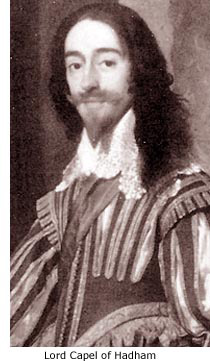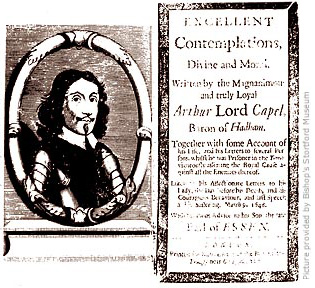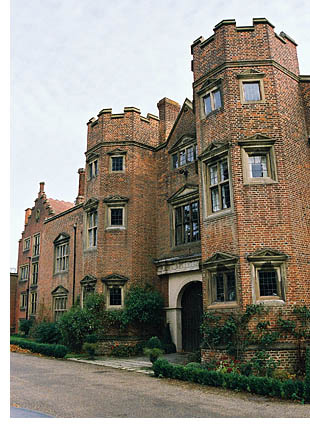|
 Between the time of the Norman Conquest in 1066 and the year 1900, just two families owned Hadham Hall – the Bauds and the Capels. The former built the first and second Hall while the latter, who purchased the second Hall in 1504 and then built the third Hall, began an ownership that added colour to its long history. Between the time of the Norman Conquest in 1066 and the year 1900, just two families owned Hadham Hall – the Bauds and the Capels. The former built the first and second Hall while the latter, who purchased the second Hall in 1504 and then built the third Hall, began an ownership that added colour to its long history.
In Bishop’s Stortford’s library there is a book, written in the 1930s entitled Twenty Centuries of England Being the Annals of Bishop’s Stortford by W. Basil Worsefold. In it are fascinating details of people and events that helped shaped the town and its surrounding area’s history, including Hadham Hall. Strictly speaking, Hadham Hall doesn’t fall within the town’s boundary, but there have always been tenuous links with Stortford and it would be a loss not to relate Worsefold's text to a wider audience.
The author did much research and was fortunate enough to have met and talked with the last owner of Hadham Hall, William Minet, who disclosed many interesting facts about its past. Added to Worsefold’s text is part of the content of a small book held in the British Museum entitled ‘Excellent Contemplations, Divine and Moral, Written by the Magnanimous and truly Loyal Arthur Lord Capel, Baron of Hadham’. The title page goes on: Together with some Account of his Life, and his Letters to several Persons, whilst he was Prisoner in the Tower vigorously asserting the Royal Cause against all the Enemies thereof. Likewise his affectionate Letters to his Lady the Day before his Death, and his Courageous Behaviour, and last Speech in his Suffering March 9. 1648 (i.e.1649)
With his Pious Advice to his son the late EARL OF ESSEX.
The book was printed in London in 1683.
 Another copy of the book, donated to the British Museum early last century, contains many added notes that interpret and supplement the text throughout, but although these notes were written by hand at about the time of publication (1683), it isn’t known who wrote them. The book also includes a vivid account of Capel’s execution at Whitehall, extracts of which are also included here. Another copy of the book, donated to the British Museum early last century, contains many added notes that interpret and supplement the text throughout, but although these notes were written by hand at about the time of publication (1683), it isn’t known who wrote them. The book also includes a vivid account of Capel’s execution at Whitehall, extracts of which are also included here.
Due to the early death of his father, Arthur Capel (1604–1649) inherited Hadham Hall from his grandfather, Henry Capel, in 1632. He was 28 years old and only a few years previous, in 1627, had married Elizabeth Morrison, heiress to the large Cassiobury estate near Watford.
In 1640 he became an MP for Hertfordshire and strongly supported the Parliamentarians who were opposed to the Royal prerogative and Charles I’s constant mismanagement of affairs. But as opposition towards Charles I increased it soon became clear to Capel that Parliament was more intent on destroying the King instead of checking his power. It was then that he changed his allegiance and supported Charles, that loyalty rewarded in August 1641 when he was created Baron Capel of Hadham.
In the coming year, economic and, more importantly, religious matters fuelled the differences between supporters of parliament and supporters of the monarchy, and the struggle for supremacy that followed ultimately lead to civil war.
When the King's situation finally became untenable in the spring of 1642, he and many of his royalist peers, including Arthur Capel, fled to York. A month later, in Nottingham, the Royal Standard was raised against the Parliamentary forces, and from that time until his imprisonment in 1648, with only one brief interval, Arthur Capel was continually in the field, fighting and raising money for Charles.
Supporters of Parliament (known as Roundheads or Puritans) came from the emerging middle classes and tradesmen of the Puritanical movement, mainly in the more prosperous southern and eastern counties. Support for the monarchy (the Cavaliers) came from peasants and nobility and the more northern and western counties. Apart from Margaret Denny of Rectory Manor in Bishop’s Stortford (See Guide 10), Arthur Capel was the only other noteworthy Royalist in this area.
Immediatley after Capel followed the King to York he was impeached for high treason by the Parliamentary leaders, and so put his estate in the hands of trustees. He had never made secret his activities in the Royalist cause and soon after war broke out, information reached Parliament that arms were stored at Hadham Hall. The majority of peers and country gentlemen had supported Charles at the outbreak of war, but among the many nobles and landowners who declared their loyalty to Parliament was the Duke of Bedford. On 29 August 1642 he rode from Woburn in Bedfordshire with a troop of horse to search Hadham Hall, and inside found enough guns with which to arm a thousand men.
After countless battles and skirmishes between the two sides over the next four years, the civil war seemingly ended on 5 May 1646 when Charles fled from Oxford to give himself up to the Scots at Newark and seek their protection. Oxford then surrendered to the Parliamentary forces and Capel returned briefly to his home.
Prolonged negotiations between the King and Parliament then took place, and for a short while it seemed possible the King would be reinstated. But the Scots reneged on their deal with Charles and in February 1647 handed him over to Parliament. The final blow came on 15 January 1648 in the vote of ‘non-address’ – the virtual dethronement of Charles.
This, however, combined with the subsequent direction of affairs of the nation, led by Oliver Cromwell and his New Model Army, produced a reaction in the King’s favour both in Scotland and England. Scottish Presbyterians, led by the Duke of Hamilton, marched south to his assistance and Royalists took to the fields in Wales, Kent and other counties. In Essex, Capel helped raise a large force of Cavaliers. The object of this resurgence was to rescue the Monarchy and Parliament from the military tyranny that threatened the existence of both.
 But the scots were soon beaten back and the Kentish Cavaliers were routed at Maidstone, after which they retreated northwards to join Royalists in Essex where they combined forces and occupied Colchester. The Roundheads then laid siege to the town and on 28 August 1648 the Royalists surrendered. Under the articles of agreement for the surrender, Capel and other prominent supporters were sent to the Tower of London, but while under arrest there he and the Duke of Hamilton managed to escape. Their freedom was brief, though, both soon recaptured and returned to the Tower. It was during his six months imprisonment there that Capel composed his book ‘Excellent Contemplations’. He also wrote letters to the Bishop of Exeter and other loyalists urging them to rescue Charles from imprisonment, and two letters to Cromwell protesting against the trial of the sovereign. But all to no avail. But the scots were soon beaten back and the Kentish Cavaliers were routed at Maidstone, after which they retreated northwards to join Royalists in Essex where they combined forces and occupied Colchester. The Roundheads then laid siege to the town and on 28 August 1648 the Royalists surrendered. Under the articles of agreement for the surrender, Capel and other prominent supporters were sent to the Tower of London, but while under arrest there he and the Duke of Hamilton managed to escape. Their freedom was brief, though, both soon recaptured and returned to the Tower. It was during his six months imprisonment there that Capel composed his book ‘Excellent Contemplations’. He also wrote letters to the Bishop of Exeter and other loyalists urging them to rescue Charles from imprisonment, and two letters to Cromwell protesting against the trial of the sovereign. But all to no avail.
Charles I was put on trial for treason in 1648 and, by a vote of 68 to 67, found guilty and executed at Whitehall on 30 January 1649. Soon after, Capel, Hamilton and other notable Royalists were brought to trial for high treason, but Capel’s only argument against the charge came later in a speech from the scaffold in Palace Yard.
However, the true bitterness of his sacrifice for the King was later revealed in two letters he wrote to his wife, Elizabeth: one written on the day of his execution, the other on the day before. He had no reproaches for false friends, no anger against relentless enemies, no pity for himself. All his thoughts were for her and those he was about to leave behind. These are the letters he wrote to his wife:
‘My dearest life, My greatest care in relation to the world, is for thy dear self... I beseech thee again and again, moderate thy apprehension and sorrow for me; and preserve thyself to the benefit of our dear children... I pray remember that the occasion of my death will give thee more cause to celebrate my memory with praise, rather than to consider it with sadness. God hath commanded my obedience to the Fifth Commandment: and for acting that duty I am condemned. God multiply all comforts to thee. I shall leave thee my dear children: in them I live with thee; and leave thee to the protection of a most gracious God. And I rest’.
On the morning of his execution he wrote...
‘My dearest Life,
My eternal life is in Christ Jesus. My worldly considerations in the highest degree thou hast deserved. Let me live long here in thy dear memory... Sorrow not unsoberly, unusually. God be unto thee better than an husband; and to my children better than a father. I am sure, He is able to be so. God be with thee, my most virtuous wife: God multiply many comforts to thee and my children, is the fervent prayer of’.
The account of Arthur Capel’s last moments before his execution was written down by Dr Morley, Bishop of Winchester, in a letter to Edward Symonds, for many years Capel’s chaplain.
‘I was there at the time assigned... But he was to have an agony before his passion; and that was the parting with his wife, eldest son, son-in-law, two of his uncles, and Sir Thomas Corbet, especially the parting with his most dear lady; which was the saddest spectacle that I ever beheld... in blessing the young lord, he commanded him never to revenge his death, though it should be in his power. The like he said unto his Lady... After this, with much adoe I persuaded his wife and the rest to be gone: and then being all alone with me, he said, ‘Doctor, the hardest part of my work in this world, is now past’....
When the bishop had prayed with him (the letter continues), ‘they were all carried to Sir Robert Cotton’s house; where I was with him, till he was called unto the scaffold, and would have gone up with him, but the guard of soldiers would not suffer me.’
Capel then gave an impassioned speech to the crowd gathered below, in which he said his obedience to Charles I, for which he had been condemned to die, was not merely no crime, but a duty enjoyed by all laws, divine and human, upon every subject of the sovereign. He ended his speech with a prayer.
The bishop’s letter continued: ‘God’s mercy on those that were the causes of his coming here’. Then the grim courtesies of the scaffold began. While he was speaking, the executioner had slipped away, and when he turned from the crowd in Palace Yard to prepare for the block, Capel looked in vain for him among the group of men, including his chaplain and Colonel Beecher, the commander of the guard, standing upon the platform. ‘Which is the gentleman?’ he asked, taking off his doublet and waistcoat. Then, when the executioner had returned and knelt to ask forgiveness, he replied, ‘I forgive thee from my soul’; and accompanied his words by a gift of five pounds. One boon he asked: the time for a short prayer after he had lain down upon the block.
The book continues:
CAPEL: Stay a little; which side do you stand upon? I think I should lay my hands that way (pointing fore-right): and answer being made ‘Yes’; he stood still a little while, and then said (speaking to his servants): Prey at the moment of striking joyn your Prayers: but make no noise; it is inconvenient at this time.
SERVANT: My lord put on your cap.
CAPEL: Should I?
Then turning to the executioner, he said, ‘Well, you are ready when I am ready, are you not?’ and then (kneeling to try the position). ‘Am I well now?’
EXECUTIONER: Yes
CAPEL: (Lying with both his hands stretched out), ‘Here lie both my hands out. When I lift up my hand thus (lifting up his right hand) then you may strike.’
With his head on the block, Capel said the prayer he had asked for then raised his two hands in signal. At one blow his head was severed. The body, with his clothes, was then taken up by the servants, put into a coffin and carried to Hadham Hall. It was then placed in the family vault beneath the altar in Little Hadham church, where, too, eleven years later his wife was laid by his side.
Lady Capel probably lived at Hadham Hall with her children until her death in 1660; the same year the monarchy was restored. Only then was it possible to place a very outspoken inscription over the common grave of the husband and wife. The stone was moved to its present position, south of the Communion table, during the restoration of the church in the 19th century but the inscription has not been touched. It reads:
Here under lyeth interred the body of Arthur Capell Baron of Hadham who was murdered for his Loyalty to King Charles the First March 9th 1648 [1649]
Here lyeth interred ye body of Elizabeth Lady Capell Wife of Arthur Lord Capell Onely daughter of Sr Charles Morrison Kt She departed this life ye 26th of Jan, 1660.
In the second copy of the book ‘Excellent Contemplations’, a note on the flyleaf tells how Capel, not content with the sacrifice of his life, ordered his heart to be preserved and laid at the King’s foot. The heart was put into a silver casket, enclosed in a box with two locks, and given to Lord Beauchamp. He retained one key and a second was given to Sir Thomas Corbet. When Beauchamp was nearing death he gave the box to Corbet who, when he approached the end of his life, gave it to Capel’s son, Arthur, then Earl of Essex.
After the Restoration (1660) no funeral Rites were performed on the body of the dead King and so the casket was laid in the Evidence Room at Hadham Hall. And there it stayed until Arthur Capel’s death in 1683, when it was found by his steward and given to the Second Earl of Essex. Not knowing what it contained he asked his mother about it and she told him of its contents. To prevent any violation of the family tomb, the heart was removed from the silver casket and placed in an iron box. This was then put into the family vault within the chancel of Little Hadham church. The silver casket was sold and the proceeds distributed to the poor of the parish.
|
